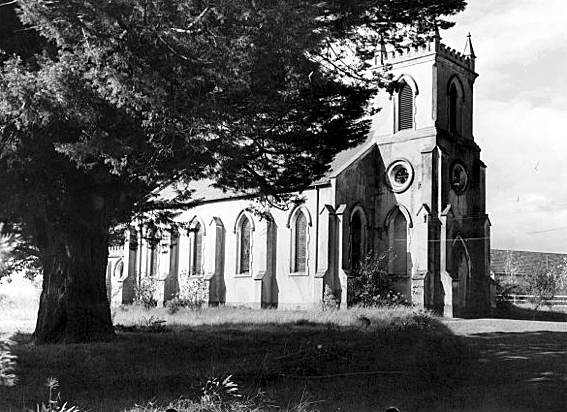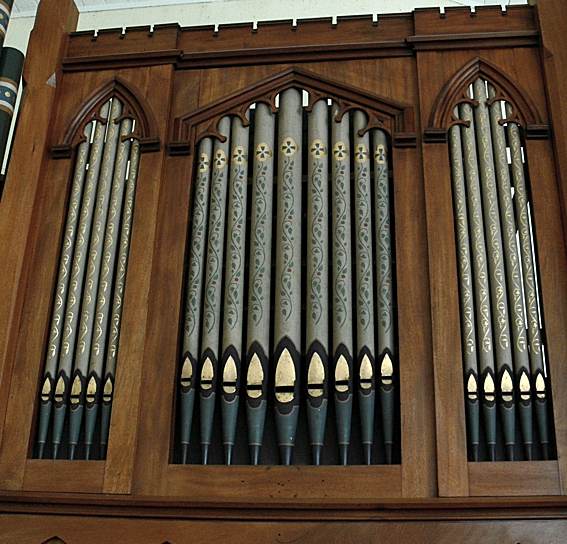
St John's Anglican Church, Heidelberg: the exterior before the changes of 1965
(photograph by Cliff Bottomley [1956])

St John's Anglican Church, Heidelberg: the exterior before the changes of 1965
(photograph by Cliff Bottomley [1956])
Historical and Technical Documentation by John Maidment
© OHTA, 2013 (last updated March 2013)
St John's Church was built 1849-51 and designed in a simple Gothic idiom by the architect John Gill. Purchas & Swyer carried out alterations in 1858, including the rebuilding of the parapet and roof, with the addition of stucco to the brickwork. In 1963-65 additional spaces were provided on either side of the tower, together with a projecting porch, and a rear gallery was added.1

St John's Anglican Church, Heidelberg: surviving casework from the 1850s organ now at Blackburn North
(photograph by John Maidment [10 March 2008])
The first organ was a barrel organ with three cylinders or barrels. This was rebuilt in 1873 by George Fincham to incorporate a keyboard. It included the following stops:2
| MANUAL Open Diapason Stopped Diapason Principal Fifteenth |
8 8 4 2 |
This instrument was removed by Alfred Fuller and incorporated into a new organ that is now at St Philip's Catholic Church, Blackburn North.

St John's Anglican Church, Heidelberg: the 1896 Alfred Fuller organ
(photograph from Robert Heatley [before 1965])
The present organ was built by Alfred Fuller, of Kew, and opened on 17 December 1896. In 1901, the Great Piccolo 2 was replaced by a Wald Flute 4.3 This organ was centrally placed on the floor of the church at the rear. It incorporated one of Fuller's 'signature' cases with the longest pipes placed on either side of the console. It remained unaltered until the mid-1960s.
The Fuller specification in 1896 was:
| GREAT Open Diapason Claribel Dulciana Principal Piccolo Swell to Great SWELL Gedackt Viola da Gamba Lieblich Flute Oboe Swell Super Octave PEDAL Bourdon Great to Pedal Swell to Pedal |
8 8 8 4 2 8 8 4 8 16 |
gvd.bass (replaced by Wald Flute 4 1901) ½ length bass |
Compass: 56/30
Mechanical key and stop action
Lever swell pedal4
When the church was extended and a rear gallery constructed, the organ was placed there and extensively rebuilt in 1965 by Davis & Laurie Pty Ltd. Fuller's immaculate action, console and casework were all removed, the action was converted to electro-pneumatic and a detached stopkey console installed. The intricate pipe decoration was eradicated.

St John's Anglican Church, Heidelberg: organ after the Davis & Laurie rebuild
(photograph by John Maidment [February 1966])
The present specification reads:
| GREAT Open Diapason Claribel Dulciana Principal Flute Fifteenth Swell Sub Octave to Great Swell to Great Swell Super Octave to Great SWELL Gedeckt Viola da Gamba Principal Mixture 19.22 Oboe Sub Octave Unison Off Super Octave Tremulant PEDAL Bourdon Principal Flute Quint Flute Great to Pedal Swell to Pedal Swell to Pedal Super Octave |
8 8 8 4 4 2 8 8 4 II 8 16 8 8 5-1/3 4 |
A B C gvd.bass A B A gvd.bass added c.1982 12 pipes + B A B B B |
Compass: 61/32
Detached stopkey console
Electro-pneumatic action5
1 Victorian Churches, edited by Miles Lewis. East Melbourne: National Trust of Australia (Victoria), 1991, p.74
2 E.N. Matthews, Colonial Organs and Organbuilders (Carlton: Melbourne University Press, 1969), p.137
3 Church minutes books 5 January 1897. 5 March 1901, cited in E.N. Matthews, ibid., p.137
4 Specification noted by D.W. Rankin 1950s
5 Specification noted by John Maidment 1966, and information in Victorian Organ Journal December 1982